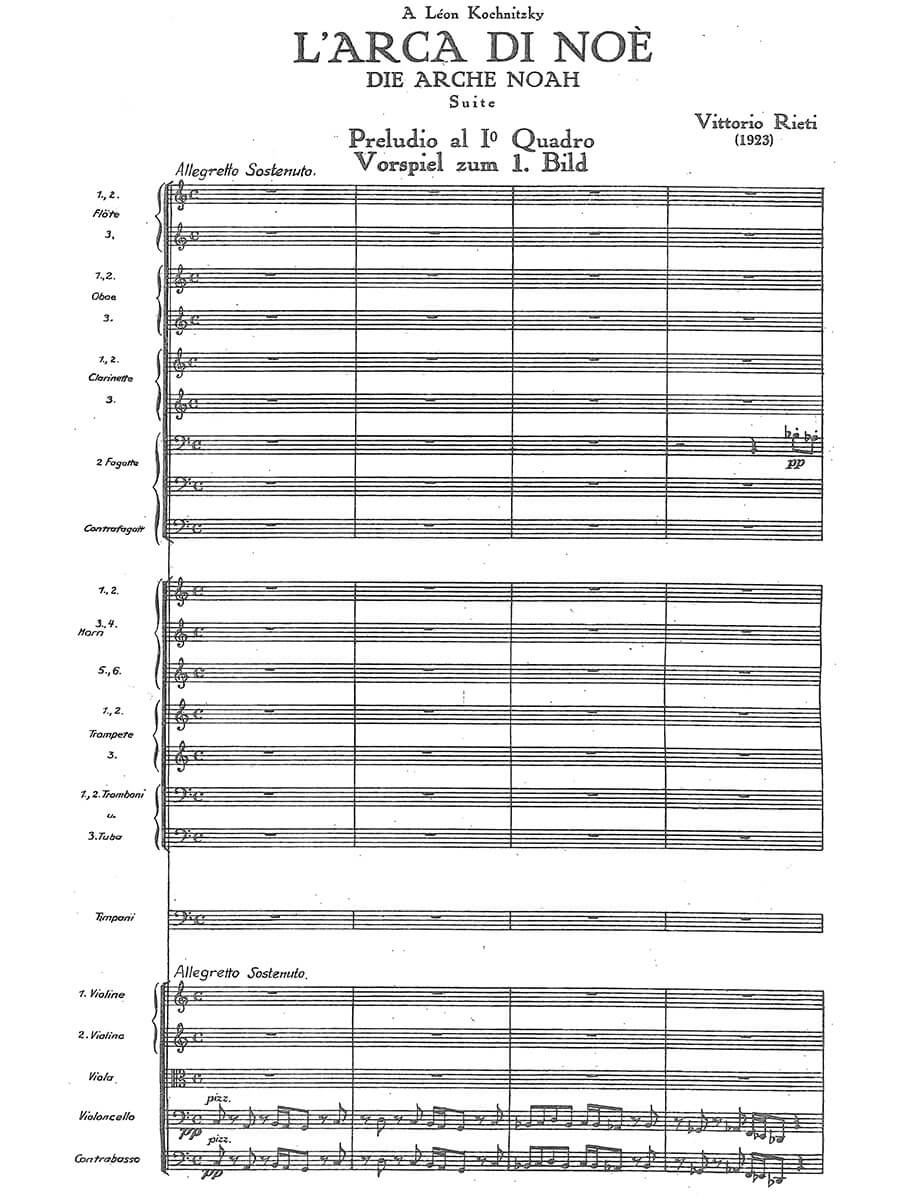L’Arca di Noè, Suite from the ballet
Rieti, Vittorio
22,00 €
Vittorio Rieti – L’Arca di Noè. Suite from the ballet
(b. Alexandria, Egypt, 28 January 1898 – d. New York, 19 February 1994)
(first performed at the ISCM Festival in Prague on 15 May 1925)
Prelude to Scene 1 – p.1
The Flood – p.6
Prelude to Scene 2 – p.25
The March of the Animals – p.28
The Rainbow – p.43
Preface (Alasdair Jamieson, 2018)
Vittorio Rieti was born to Italian Jewish parents in Egypt; he was one of four children. He studied at the local technical college in Alexandria, but moved – without the rest of his family – to Milan at the tender age of 13, to enrol in the Università Commerciale Luigi Bocconi from where he graduated in economics in 1917. During this period he was taking lessons in composition and piano from Giuseppe Frugatta at the Conservatorio di Milano. After brief war service he moved to Rome with his family, and he took lessons with Respighi, Casella and Malipiero; under their influence he quickly became familiar with both national and international musical trends. In the early 1920s he inaugurated a compositional umbrella group I Tre with Renzo Massarani and Mario Labroca, in imitation of the francophone Les Six. Rieti had started composing when only 12 years old, but by 1920 he had at least 40 works to his name – many subsequently repudiated and destroyed. In 1921 he showed Arnold Schönberg three of his compositions in Vienna and received encouraging feedback from him. No less important was the publishing contract he secured, with the help of a letter of recommendation from Respighi, with the Viennese firm, Universal Edition. Rieti married Elsie Rappaport in 1924, with whom he would have a son, Fabio. In the same year Vittorio broke onto the international scene when at the ISCM Festival in Prague Casella conducted his Concerto for Wind Quintet and Orchestra; the work was immediately taken up by Fritz Reiner and Willem Mengelberg, who performed it in the USA, Holland and in other countries. When the Concerto was performed in Paris in 1925 Poulenc and Messager were in the audience and surmised that Rieti’s music with its neoclassical verve and rhythmic energy might make him an ideal composer for Diaghilev’s Ballets Russes. A meeting was arranged, and this would lead to two works for the Ballets Russes: Barabau (1925) and Le Bal (1929), this latter with costumes and décor by di Chirico. Rieti composed much incidental music for the Parisian theatre of Louis Jouvet, and was also a founder member of La Sérénade (1931-1940), a group dedicated to modern chamber music. Although Rieti had divided his time between Paris and Rome during the interwar years, he started to avoid Italy during the later stages of the Fascist ventennio, particularly given the implementation of the Race Laws in 1938. In 1940 he moved to the USA and became a citizen of that country after four years. His ballet music, especially The Night Shadow (on themes from Bellini’s La Sonnambula) was choreographed by Balanchine. Mitropoulos, Désormière and Toscanini conducted his orchestral compositions. Rieti taught composition at the Peabody Conservatory (1948-1949), at the Chicago Musical College (1950-1953), at Queens College (1955-1960), and at the New York College of Music (1960 to 1964). He was a prolific composer, and he kept writing up to his death at the age of 96: ‘composing every day is what keeps me alive’. In his 75th, 80th and 85th birthday years, there were commemorative concerts in New York that included many new works. ‘Vittorio Rieti is becoming something of a wonder,’ Allen Hughes wrote in The New York Times after a 1985 concert. ‘He will be 87 years old later this month, but he is still composing music that is as sprightly and cheerful as anything he ever wrote.’ His compositional style in its wit, craft, lack of pretence and economy of means shares similarities with the work of Les Six, and also that of Stravinsky, a close personal friend. It was style that would be refined and amended but not substantially altered throughout the composer’s long career: in his own words, 2I have kept evolving in the sense that one keeps on perfecting the same ground.’
His oeuvre includes a dozen ballets, seven operas, five symphonies, several concertos, chamber music for a wide variety of instrumental combinations, songs and choral works. Casella, writing back in 1927 had already perceived Rieti’s worth: “He already possesses those fine qualities that many other composers look for without finding throughout their whole career: a style, a personality, and a security in matters of form and technique which in his case (with no exaggeration) can be called mastery.”
Read full preface > HERE
| Score No. | 3085 |
|---|---|
| Edition | Repertoire Explorer |
| Genre | Orchestra |
| Size | |
| Printing | Reprint |
| Pages | 62 |
